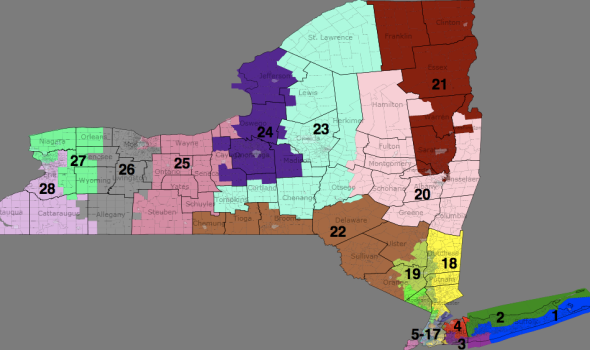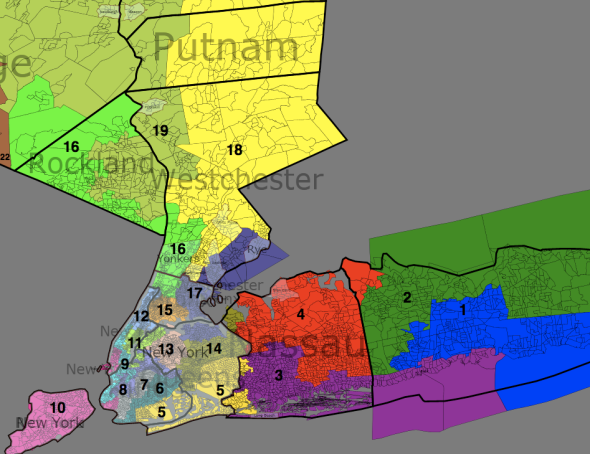John Cherry confirmed this morning that he will not be a candidate for governor of Michigan this year.
Month: January 2010
Democratic Governors Association raised big money in 2009
Democratic incumbent governors are facing some tough races in 2010, but fortunately the Democratic Governors Association will be in a position to help in key states.
Link:
The Democratic Governors Association raised $23.1 million in 2009, more than ever before in the organization’s history, and will start the 2010 election cycle with nearly 12 times as much cash on hand as 2006, the last equivalent election cycle, Chairman Gov. Jack Markell announced today. […]
The DGA’s 2009 fundraising marks the second year in a row and the first off-year in which the DGA raised more than $20 million. Fourth quarter fundraising was by far the strongest, with more than $7 million in contributions received during the period. December contributions alone totaled nearly $4 million.
The record-breaking fundraising means that the DGA begins 2010, the most critical gubernatorial cycle in a generation, with $17.5 million on hand. In the equivalent election cycle in 2006, the DGA carried over $1.5 million and spent less than $14 million on races that year.
The Republican Governors Association has historically outraised the DGA by wide margins. In spite of the fundraising gap, since 2007, the DGA has won twice as many targeted governors races as the RGA. The DGA’s strong cash-on-hand position means that it will be able to spend at a competitive level with the RGA in this critical cycle.
Losing the governor’s races in New Jersey and Virginia was painful enough, and I am glad to know that those campaigns didn’t deplete the DGA’s cash reserves.
Here in Iowa, Governor Chet Culver may need the DGA’s help to keep pace with Republican expenditures. Culver held lots of fundraisers during the fall, but he also spent money running a couple of television commercials statewide. The leading Republican challenger, Terry Branstad, probably pulled in big numbers during the fourth quarter, although he will have to spend a lot of cash before the Republican primary in June. The other strong Republican candidate, Bob Vander Plaats, has a lot of support from conservative activists and should have the resources to run a solid campaign.
Most Recent Times Rasmussen has been wrong
Since there has been so much talk about Rasmussen polls andwhether or not they are accurate, I decided to post some of the most recent times Rasmussen was wrong.
NC-GOV: 2008
Rasmussen Final Poll
51% McCrory
47% Perdue
Actual Result
50% Perdue
47% McCrory
MN-SEN: 2008
Rasmussen Final Poll
43% Coleman
39% Franken
Actual Result
42% Franken
42% Coleman
Florida President-2008
Rasmussen Final Poll
50% McCain
49% Obama
Actual Result
51% Obama
48% McCain
North Carolina President-2008
Rasmussen Final Poll
50% McCain
49% Obama
Actual Result
50% Obama
49% McCain
Indiana President-2008
Rasmussen Final Poll
49% McCain
46% Obama
Actual Result
50% Obama
49% McCain
MO-SEN: 2006
Rasmussen Final Poll
49% Talent
48% McCaskill
Actual Result
50% McCaskill
47% Talent
SSP Daily Digest: 1/4
• KY-Sen: I’ve never heard of Bill Johnson before, but bringing six figures to the table is bound to gain some attention. The western Kentucky businessman, who’s running in the Republican Senate primary, said he’s loaning himself $250,000 to try and garner some notice in the big-$ primary between Trey Grayson and Rand Paul.
• LA-Sen: I never thought I’d see the day when urea formaldehyde would become a campaign issue, but Democrats are hoping to use it against David Vitter in the Bayou State. Vitter (who has the backs of Louisiana’s large chemical industry) has been placing a hold on a new EPA administrator’s nomination, partly over concerns that the EPA will more heavily regulate formaldehyde. Unfortunately for Vitter, more than 34,000 Louisiana residents have first-hand experience with urea formaldehyde, outgassing from the paneling of their FEMA-provided post-Katrina trailers.
• MA-Sen: Republican State Sen. Scott Brown has an uphill fight in this month’s special election to overcome the state’s Dem lean and perhaps sentimental desires to keep Ted Kennedy’s seat in Democratic hands. Still, he got an endorsement from the state’s most popular conservative: Red Sox great Curt Schilling.
• NH-Sen: Salt shaker at the ready? ARG has a new poll out of general election matchups in the New Hampshire Senate race, showing a single-digit edge for Republican AG Kelly Ayotte over Democratic Rep. Paul Hodes, 43-36 (their last poll, from September, also gave Ayotte a 7-pt edge). They also poll Hodes against conservative upstart Ovide Lamontagne for the first time, and, in a bit of a head-scratcher, find a similar margin for the less-known and, one would think, less electable Lamontagne, who leads Hodes 37-31.
• MI-Gov: Here’s a Rasmussen poll that slipped our notice over the holidays; as one might expect, Santa Rasmussen had a big lump of coal for John Cherry’s stocking. All three Republicans lead the Democratic Lt. Governor, as other pollsters generally find, but Rasmussen still manages to depart from the other pollsters’ findings: AG Mike Cox, who has generally polled the best against Cherry, here has the smallest edge over him (only 39-34), while loudmouthed right-wing Rep. Pete Hoekstra has the biggest edge (46-32). (This poll was taken before Hoekstra’s grandstanding over the attempted plane bombing, which would serve to raise his name rec outside his western Michigan home turf.) Oakland Co. Sheriff Mike Bouchard leads Cherry 42-32. One hope for Cherry, though, is that, in terms of favorables, he still has higher unknowns than any of the Republicans, giving him room to grow.
• RI-Gov: Jan. 4 has been penciled in as the official launch date for Lincoln Chafee’s independent campaign for Rhode Island for a while now. With it comes news that (against a backdrop of mediocre fundraising so far) he’ll be dipping into the family fortune to propel his race; he just lent his campaign another $200K after starting it off with a previous $110K. Compared with Dem state Treasurer Frank Caprio’s $1.5 million, Chafee has a lot of ground to make up. Meanwhile, Republicans would still like a candidate… any candidate.
• AL-05: Looks like recent turncoat Parker Griffith is having a busy day today, answering his own phones and making his own coffee. Almost his entire staff resigned en masse today, unwilling to join him on his foray into the Republican fold.
• CA-19: Another sort-of-well-known Republican is scoping out the new open seat in the 19th: former SoS, former Assembly minority leader, and 2004 Senatorial loser Bill Jones is considering the race. Fresno city councilor Larry Westerlund is also looking at the race, which already has state Sen. Jeff Denham and former Fresno mayor Jim Patterson in the GOP field… and, as of this afternoon, former CA-11 Rep. Dick Pombo. (I wonder if Tom McClintock is interested in running here? He’s gotta be feeling restless again, having represented CA-04 for a full year now.)
• MN-01, MN-02, MN-03: We might actually wind up with a Democratic former elected official running in John Kline’s 2nd but not in the theoretically more-vulnerable 3rd next door. Former state Rep. Shelly Madore of Apple Valley (who was defeated by a Republican in 2008) has decided to get into the race in Minneapolis’s southern suburbs. (H/t Andrew.) Speaking of the 3rd, Democratic challenger Maureen Hackett is the first to hit the airwaves with a new radio spot; she faces a primary fight with state PTA president Jim Meffert, and the winner takes on freshman Republican Rep. Erik Paulsen. Finally, as expected, it only took Republican ex-state Rep. Allen Quist a few weeks to start bringing the crazy over in the 1st, as seen in recent comments that beating “radical” Democrats in Washington is a bigger battle than beating terrorism.
• NY-20, NY-Comptroller: Republican John Faso (the former Assembly minority leader and 2006 gubernatorial loser) was getting touted for a number of different races: for a run for Comptroller, against Rep. Scott Murphy in the 20th, or maybe even for NY-Sen-B if no other Kirsten Gillibrand challenger stepped up. It looks like he won’t be doing any of those things, saying it’s “doubtful” he’ll run for anything this year. State party chair Ed Cox is pushing Emil Henry Jr. for the GOP’s Comptroller slot now (Henry, a former Lehman Bros. exec, had earlier been trying to generate some interest for a gubernatorial run, apparently to little avail).
• PA-04: Insiders are leaking that former W.D. Pa. US Attorney (and loyal Bushie) Mary Beth Buchanan is increasingly likely to run against Rep. Jason Altmire this year, although the word is she’ll make her decision “soon.” On the flipside, this may mean the likelihood of state House minority whip Mike Turzai running for the GOP is going down.
• TN-08: Jackson-area physician Ron Kirkland will be joining the GOP field, now that this seat is a more tempting target with the retirement of long-time Democratic Rep. John Tanner. Kirkland joins “farmer” (or agribusiness kingpin, if you prefer)/gospel singer Stephen Fincher, who’s already off to a big fundraising start.
• TX-10: With a nasty hole in the lineup looming with the departure of promising candidate Jack McDonald, here’s a big-time save by veteran Ted Ankrum, who’ll file to take McDonald’s place in the 10th. Ankrum, you might recall, was our 2006 nominee in the 10th, and his strong performance with almost no funding is what drew a lot of Dem attention to the potential winnability of this rapidly-bluening seat. (Speaking of filing, the filing deadline in Texas is today. Primaries are soon, too – March 2nd, with potential run-offs on April 13th. Check out SSP’s full sortable primary calendar, if you haven’t before.)
• GA-SoS: With current Secretary of State Karen Handel resigning midterm in order to pursue her gubernatorial bid, Republican Gov. Sonny Perdue got the chance to hand-pick a successor. 38-year-old state Rep. Jim Cole, a member of the House’s leadership, will serve out the remaining year of her term and then run for a full term in 2010. (UPDATE: Or not. Cole has already turned down Perdue’s offer; former state Sen. Brian Kemp now sounds likely to be offered the job. H/t RuralDem.)
• Mayors: Lt. Gov Mitch Landrieu’s path to be the next mayor of New Orleans looks even easier now. His main opposition, state Sen. Ed Murray, opted to drop out, acknowledging that he didn’t want to suffer through an expensive and racially-divisive (Murray is African-American) campaign.
• NRCC: Looks like we’re not the only ones taking notice of the NRCC’s cash-on-hand problems, as the legacy media start to take notice: Politico observes that right now the NRCC has enough money to fund about one big-name House race, not the dozens they’re trying to put into play with various recruiting successes.
• RNC: Reid Wilson has an interesting catch: the RNC is sending money ($20K) to the local party in the Northern Mariana Islands (popu. 86,000), which, of course, don’t have a voting member of the House or any electoral votes. It looks like it may be a little payback from Michael Steele, who owes his chairmanship to votes from the NMI and other insular territories.
• Polltopia: Politico also belatedly picks up on another favorite theme in the liberal blogosphere: what the hell is up with Rasmussen’s numbers? Nate Silver judiciously examined the issue too, over the weekend, pointing out that Rasmussen’s well-documented “house effects” aren’t necessarily indicative of bias per se. Rasmussen’s defenders, of course, will point to Nate’s ratings of Rasmussen’s accuracy, which are high; fitting, as their numbers do tend to converge with reality in a race’s final weeks (as we saw last November in NJ and VA). Still, one question wasn’t raised in either of these pieces over the weekend: how to hold Rasmussen to account for showing out-of-whack numbers long before the election, before they start to fall in line with everyone else (and when they, by virtue of Rasmussen’s frequent polling, can play a large role in shaping the conventional wisdom about who’s up and who’s down)?
• Maps: A denizen of the forums at Dave Leip’s site has put together an even better set of maps of presidential election results by county, dating back to 1840. (H/t metstotop333.)(D)
• Redistricting: A reminder – if you post an entry in the redistricting contest, please e-mail your .DRF.XML file to jeffmd [at] swingstateproject [dot] com. (Instructions for finding your file are here.) This will make it a lot easier for Jeff to judge entries. And the deadline to submit your entry is fast approaching – Sunday, January 10th at midnight Eastern time. (D)
Also, on the redistricting front, Politics Magazine has a lengthy piece on Democrats’ efforts to avoid getting out-hustled by the GOP in both congressional and state-level redistricting. Hint to Bill Burke’s Foundation for the Future and Brian Smoot’s Democratic Redistricting Trust: Reach out to the redistricting geeks here at the Swing State Project. We’re a great untapped resource. One interesting note: This is the first time since the passage of the Voting Rights Act that the White House (and thus the Department of Justice) will be in Democratic hands during the start-to-finish redistricting process. (D)
• Census: The Census Bureau is rolling out a $340 million ad blitz over the next few months to make sure that everyone knows about the Census and that they need to participate. The rollout includes two ads (directed by Christopher Guest and starring Ed Begley Jr., which ought to get the right-wingers a-foamin’ at the mouth) during the Super Bowl, but also $80 million in ad outreach to non-English-speaking populations. Talking Points Memo also has a neat observation about Rep. Michele Bachmann, once the Census’s greatest foe but who’s been surprisingly quiet in her criticisms of it lately: she may need to rely on huge Census turnout by Minnesotans to keep Minnesota at 8 seats, and thus, keep her own seat (the likeliest target for elimination if the state needs to drop to 7 and Dems exclusively control the process).
SC-01: Henry Brown Calls It Quits
It looks like House Democrats aren’t the only ones heading to the exits this year — electorally-vulnerable Republicans can get in on the act, too! Cue up a retirement from an oh-so-unsurprising source: GOP Rep. Henry “Smokey” Brown. From the Politico:
Rep. Henry Brown, a five-term South Carolina Republican from a conservative-leaning district, has told associates he will his announce his retirement Monday, POLITICO has learned.
He will be making his announcement at a press conference tomorrow afternoon back in his coastal Carolina district
Brown survived a closer-than-expected re-election in 2008 and was already facing a primary challenge from Carroll Campbell III, the son of the former GOP governor and congressman.
Brown, who was nearly decapitated by Democrat Linda Ketner in 2008, was facing a potentially crowded primary from “Tumpy” Campbell, Mt. Pleasant Town Councilman Mark Fava, Isle of Palms councilman Ryan Buckhannon, and “frequent candidate” Katherine Jenerette. Attorney Paul Thurmond (Son of Strom) has also been in the mix as a potential GOP candidate.
Democrats have been making noises about seriously contesting this coastal R+10 district again this year, but it’s unclear who will be the nominee. One of the leading contenders for the nomination, state Rep. Leon Stavrinakis, said that he would make a decision last July, but has since remained silent on the subject. Georgetown restauranteur Robert Dobbs, a political newcomer, is in. Robert Burton, a former South Carolina Housing, Finance, and Development Authority Commissioner and U.S. Air Force Colonel, is also in. Burton has a bit more political seasoning — he lost a statewide race for SC Adjutant General in 1998. Retired navy officer and accountant Dick Withington rounds out the current primary field. Attorney Ashley Cooper, a former Fritz Hollings aide, has also been reportedly mulling the race. We’ll see how this one shakes out.
UPDATE (Cristunity): Politico is rolling out lots of names of potential other Republicans in addition to the ones we’ve already mentioned. Most notable may be former Rep. Tommy Hartnett, who held the forerunner to this seat in the 80s. (Hartnett is 68, not much younger than the retiring Brown.) Other potential names listed by former state chair (and almost RNC chair) Katon Dawson include state Sen. Luke Rankin, state Rep. Chip Limehouse, and state Sen. Chip Campsen. The rumor mill also points to state Sen. Raymond Cleary, state Rep. Alan Clemmons, and… this seems like an out-of-the-box pick, but she may have emerged from last years’ events with her personal popularity increased… first lady Jenny Sanford. Finally, on the Dem side, it’s worth noting that restaurant owner Robert “Bob” Dobbs does have a political track record, as a former county commissioner — unfortunately, that was in Manitowoc County, Wisconsin.
RaceTracker Wiki: SC-01
Contest Entry: New York 28-0
Overall Plan
This entry in the redistricting contest creates 28 Democratic seats and 0 Republican seats. I expect Peter King to lose against Carolyn McCarthy, Chris Lee to lose against Brian Higgins, two Democrats to win in new districts, and one of Scott Murphy or Bill Owens to lose in a primary.
I aimed for compact districts, by and large. Some districts stretch this a little (e.g., 16 and 18), but most are more compact than they used to be. There are no earmuffs like NY-26. There are no water connections over uninhabited islands like NY-08. There’s no connecting through a Con Ed plant to pick up population from Rikers Island like NY-15. Perhaps the only cheap trick was connecting the new Velázquez district through Prospect Park. I even refrained from drawing a thin tendril from Meeks’s district to King’s house.
I was very careful to ensure that a representative actually lives in a district if I assert that I’m drawing a district for him or her. This was rather constraining in several cases. However, I avoided relying on incumbency to keep districts safe, since most of the NY delegation will retire before the next round of maps goes into effect in January 2023.
Along a similar line, I tried to keep Democratic incumbents with at least some of their base of support. For example, since Massa’s current district runs to the Rochester suburbs, I kept it that way rather than giving him some kind of Buffalo-based or Binghamton-based creation. (But when an incumbent, such as Slaughter, has two very distinct bases of support, I only aimed to keep one of them – in Slaughter’s case, it was Rochester rather than Buffalo.) Our incumbents have worked hard to build relationships with local leaders and activists in their current districts, and I’d rather not take that away from them.
All districts are within 100 votes of the target population, except for the three westernmost districts, which are within 200.
Districts by Geography
On Long Island, I’ve reconfigured the two Suffolk districts into an east-west alignment to even out the Democratic advantage between them. In Nassau, I’ve carved King’s district up between Ackerman (whose district is now almost entirely outside the City) and McCarthy, and placed some Republican areas along the NYC border into Meeks’s and Weiner’s districts.

In Queens, Meeks’s district is roughly the same as before, although it now encompasses some Black and Republican areas in Nassau and Brooklyn. Weiner’s district is still based in Forest Hills, but now spills eastward towards Nassau rather than westward into Brooklyn. Lowey’s new district reaches down into Whitestone. Crowley’s district has been consolidated into a compact area of western Queens, and Maloney still has about the same area.
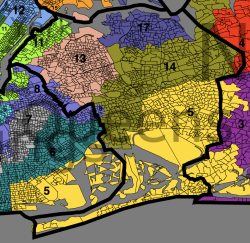
Most of Brooklyn is in VRA districts. Velázquez’s district is heavily Democratic, since I found that I had to use almost entirely Democratic precincts in order to build a 48% Hispanic district. However, I found that it was easy to build solidly Democratic 50% Black districts that had spare capacity to take on Republicans from southern Brooklyn. Therefore, most of southern Brooklyn is divided among the 50% Black VRA districts of Meeks, Towns, and Clarke. Most of the remainder (White Democratic areas like Brooklyn Heights and Park Slope) goes to Nadler, while McMahon and Maloney each represent small areas near the cores of their districts.
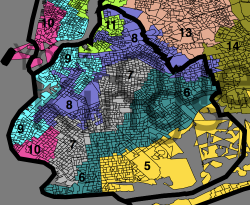
Staten Island is in McMahon’s district. If McMahon were to lose in 2010, I would want to split the island across two safely Democratic districts.
Lower Manhattan is split between McMahon (who needs the Democratic votes) and Nadler. Midtown and Uptown up to about 96th are split between Nadler and Maloney, as is roughly the case today. Harlem is still in Rangel’s district.
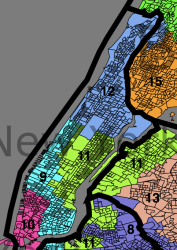
In the Bronx, Serrano’s district is substantially similar to its current form, although Rangel and Engel both get some of his current Democratic Hispanic votes. The rest is split among two of the districts districts that extend up into Westchester and beyond.
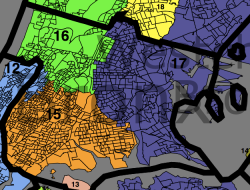
I have divided the northern Metro Area into four districts. Two (Engel and Lowey) have significant Democratic populations from New York City, which allows Engel to take Republican precincts from further Upstate. Hall also extends through Democratic areas nearly to NYC, which allows him to take Republican precincts from further Upstate as well. In particular, Rockland County is carefully divided between Republican precincts (which go to Engel) and Democratic precincts that can be used elsewhere. This allows me to create a fourth new district in the Hudson Valley, which goes from Poughkeepsie down to New City.
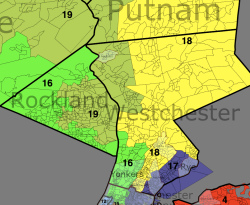
I split the Capital Region into two districts, one for Tonko and one for either Murphy or Owens. I judged Owens’s current district too tenuous to maintain in its existing form, so I split the North Country into three parts to attach to Maffei’s, Arcuri’s, and Murphy or Owens’s districts.
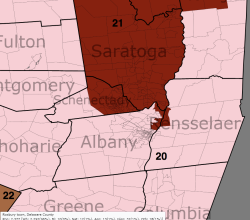
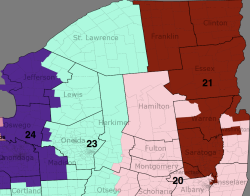
In Central New York, Utica and Syracuse each have one district. Binghamton also has a district, which extends eastward to Kingston and Middletown, as it does today. However, I transferred Ithaca from Hinchey to Arcuri in order to solidify Arcuri.
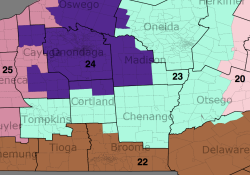
After the 2000 Census, the redistricters drew four districts for Western New York, intending to have them split 3-1 Republican. Their map connected parts of Rochester and Buffalo along a narrow strip to create a packed Democratic district, and then splintered the remaining Democrats among three other districts that they intended for Republicans. However, the four-district region as a whole leans Democratic, so one can create four Democratic districts just by giving each of the four districts an equal number of Democrats. In order to prevent Lee from stealing a district, I’ve put his residence into Higgins’s district and have drawn the incumbent-less district so that it has more Democrats than the other three.

District Summaries
NY-01
Incumbent: Tim Bishop (D) lives in precinct Southampton 6.
Population: 700259
| Wh | Bl | Hisp | Asn | Nat | Oth |
|---|---|---|---|---|---|
| 75 | 6 | 15 | 2 | 0 | 2 |
| New | Old 1 | |
|---|---|---|
| Obama % | 53.91 | 51 |
| McCain % | 45.56 | 48 |
Description: District 1 covers the southern half of Suffolk County, from Brentwood and Central Islip out to the Hamptons. It omits a strip of Republican land along the beach opposite Jones Beach and Fire Islands.
The current NY-01 was drawn to favor a former Republican incumbent, Felix Grucci, and contains all of Republican-leaning eastern Suffolk. In order to equalize the Democratic performance of Districts 1 and 2, I’ve reconfigured them so that each one gets a share of Republican-leaning eastern Suffolk. Thus, a large number of people from the North Fork are moving from NY-01 to NY-02, and a large number of people from the neighborhood of Brentwood and Central Islip are moving from NY-02 to NY-01.

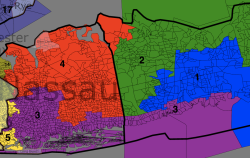
NY-02
Incumbent: Steve Israel (D) lives in precinct Huntington 100 in Dix Hills.
Population: 700383
| Wh | Bl | Hisp | Asn | Nat | Oth |
|---|---|---|---|---|---|
| 81 | 8 | 7 | 3 | 0 | 1 |
| New | Old 2 | |
|---|---|---|
| Obama % | 53.36 | 56 |
| McCain % | 46.49 | 43 |
Description: District 2 covers the northern half of Suffolk County, from Huntington and Commack, out through Coram to the North Fork.


NY-03
Incumbents: Carolyn McCarthy (D) lives in precinct North Hempstead 111 in Mineola; Peter King (R) lives in precinct Hempstead 36 in Seaford.
Population: 700386
| Wh | Bl | Hisp | Asn | Nat | Oth |
|---|---|---|---|---|---|
| 73 | 11 | 11 | 3 | 0 | 2 |
| New | Old 3 | Old 4 | |
|---|---|---|---|
| Obama % | 53.23 | 47 | 58 |
| McCain % | 46.04 | 52 | 41 |
Description: District 3 covers Democratic southwestern Nassau County (Hempstead, Garden City, Valley Stream, Freeport) along with a strip of Republican territory on the shore well into Suffolk County.
In 2008, King outperformed McCain significantly in his district, while McCarthy outperformed Obama modestly in her district. In an incumbent-incumbent race, I expect McCarthy to be able to win in a D-leaning district with 22% Black+Hispanic, particularly since about 2/3 of the district’s population comes from her old NY-04.

NY-04
Incumbent: Gary Ackerman (D) lives in precinct North Hempstead 99 in Roslyn Heights.
Population: 700388
| Wh | Bl | Hisp | Asn | Nat | Oth |
|---|---|---|---|---|---|
| 79 | 6 | 8 | 6 | 0 | 1 |
| New | Old 3 | Old 5 | |
|---|---|---|---|
| Obama % | 52.88 | 47 | |
| McCain % | 46.35 | 52 |
Description: District 4 covers most of northern and eastern Nassau County, including Levittown, Hicksville, Oyster Bay, and Port Washington.
This coincides in large part with Peter King’s old NY-03. However, it also includes Democratic territory around Plainview and Port Washington, and it excludes the Republican shore. If King moved into this new district, he could conceivably pull an upset if Ackerman has forgotten how to run a competitive race. (This would be similar to how Tim Holden upset George Gekas in central Pennsylvania after they were thrown together in a Republican-leaning district.)


NY-05
Incumbent: Gregory Meeks (D) lives in precinct Queens 33-28 in St. Albans.
Population: 700255
| Wh | Bl | Hisp | Asn | Nat | Oth |
|---|---|---|---|---|---|
| 28 | 50 | 11 | 5 | 0 | 5 |
| New | Old | |
|---|---|---|
| Obama % | 78.94 | 89 |
| McCain % | 20.73 | 11 |
Description: As a VRA district, District 5 covers the Black areas of eastern Queens, St. Albans and Far Rockaway. It also covers several nearby Republican areas: the Five Towns, Rockaway Peninsula, and (through a connection across the Flatbush Ave. Bridge) Sheepshead Bay and Manhattan Beach.
This district achieves its required 50% Black population in southeastern Queens, and then uses its spare capacity to help achieve two goals: 1) It takes Republican votes from the Five Towns that might otherwise help King. 2) It helps break up the large White Republican sections of southern Brooklyn into irrelevant pieces. Currently, Weiner’s district achieves this second goal, but I prefer to use Weiner to inoculate Republican votes in Queens.
One more thing: For historical reasons, Section 5 of the VRA does not apply to Queens, only to the other three major boroughs. I think it would be a good thing to investigate whether Meeks’s district could be broken up to help out McCarthy and Ackerman against King. Meeks could still win a ~40% Black district handily. But maybe there’s a Section 2 thing that I’m not understanding?



NY-06
Incumbent: Ed Towns (D) lives in precinct 54-56 in East New York.
Population: 700355
| Wh | Bl | Hisp | Asn | Nat | Oth |
|---|---|---|---|---|---|
| 30 | 50 | 13 | 4 | 0 | 3 |
| New | Old 10 | |
|---|---|---|
| Obama % | 79.82 | 91 |
| McCain % | 19.9 | 9 |
Description: As a VRA district, District 6 covers certain Black areas of Brooklyn (East New York, Brownsville, Canarsie, Flatlands). It also covers some nearby Republican areas around Gravesend and Brighton Beach.
This is another “Blacks and Republicans” district that achieves its required 50% Black population in one area, and then stretches out to White southern Brooklyn to split up the McCain votes there.

NY-07
Incumbent: Yvette Clarke (D) lives in precinct Brooklyn 43-78 in Prospect Gardens.
Population: 700389
| Wh | Bl | Hisp | Asn | Nat | Oth |
|---|---|---|---|---|---|
| 31 | 50 | 9 | 7 | 0 | 3 |
| New | Old 11 | |
|---|---|---|
| Obama % | 79.31 | 90 |
| McCain % | 20.33 | 9 |
Description: As a VRA district, District 7 covers certain Black areas of Brooklyn (Bed-Stuy and Crown Heights). It also covers some nearby Republican areas, such as Mapleton and Bensonhurst.
This is another “Blacks and Republicans” district that achieves its required 50% Black population in one area, and then stretches out to White southern Brooklyn to split up the Republican votes there. Currently, Nadler’s district does this, but I prefer to make Nadler’s district less spectacularly gerrymandered than it is today.

NY-08
Incumbent: Nydia Veláquez (D) lives in precinct Brooklyn 72-100 in Carroll Gardens.
Population: 700328
| Wh | Bl | Hisp | Asn | Nat | Oth |
|---|---|---|---|---|---|
| 19 | 20 | 48 | 9 | 0 | 4 |
| New | Old 12 | |
|---|---|---|
| Obama % | 88.22 | 86 |
| McCain % | 11.14 | 13 |
Description: As a VRA district, District 8 covers Hispanic areas of Brooklyn (Bushwick, some of Williamsburg, Boerum Hill, Sunset Park, and Kensington). It connects the two large Hispanic populations with a narrow strip through Prospect Heights and Prospect Park.
The Hispanic population of Brooklyn is barely large and concentrated enough to sustain a high-percentage district. Because of this, I avoided putting any nearby non-Hispanic areas in the district, such as Park Slope, Greenpoint, or the Republican sections of southern Brooklyn.


NY-09
Incumbent: Jerrold Nadler (D) lives in precinct Manhattan 35-67 on the Upper West Side.
Population: 700352
| Wh | Bl | Hisp | Asn | Nat | Oth |
|---|---|---|---|---|---|
| 52 | 11 | 18 | 16 | 0 | 3 |
| New | Old 8 | |
|---|---|---|
| Obama % | 85.33 | 74 |
| McCain % | 13.85 | 25 |
Description: District 9 runs from the UWS, through Chelsea, and over to the LES. Then it crosses the Brooklyn and Manhattan Bridges, and covers several neighborhoods in Brooklyn: Brooklyn Heights, Park Slope, Red Hook, and Bay Ridge.
The Brooklyn portion of the district consists (by and large) of White Democratic neighborhoods. These are the neighborhoods that are not covered by the VRA districts.
I would ideally like to extend this district far enough down into Bay Ridge so that McMahon’s district would contain none of Brooklyn. However, it is difficult to do this and still have the district reach Nadler’s apartment on 70th St. In the end, I’m satisfied that McMahon’s district is sufficiently Democratic.


NY-10
Incumbent: Mike McMahon (D) lives in precinct Staten Island 61-35 on the northern part of the island (I don’t know neighborhood names).
Population: 700426
| Wh | Bl | Hisp | Asn | Nat | Oth |
|---|---|---|---|---|---|
| 72 | 7 | 11 | 8 | 0 | 2 |
| New | Old 13 | |
|---|---|---|
| Obama % | 57.29 | 49 |
| McCain % | 41.95 | 51 |
Description: District 10 covers all of Staten Island, part of Bay Ridge in Brooklyn (connected by the Verrazano-Narrows Bridge), and the western half of Lower Manhattan (connected by the Staten Island Ferry).
The existing NY-13 was drawn to favor former Republican congressman Vito Fossella. A major goal of any Democratic redistricting should be to make this into a safe Democratic district. I accomplish this by adding a large portion of heavily Democratic Lower Manhattan. If there were a Republican incumbent, I would have split Staten Island into two pieces in order to guarantee the Republican’s defeat. However, that seems like overkill to shore up the seat for a sitting Democrat.


NY-11
Incumbent: Carolyn Maloney (D) lives in an unknown precinct on the Upper East Side (I’m assuming between 59th and 96th).
Population: 700270
| Wh | Bl | Hisp | Asn | Nat | Oth |
|---|---|---|---|---|---|
| 70 | 4 | 13 | 4 | 0 | 3 |
| New | Old 14 | |
|---|---|---|
| Obama % | 77.09 | 78 |
| McCain % | 22.06 | 21 |
Description: District 11 covers the Upper East Side and Midtown East in Manhattan, Astoria and Long Island City in Queens, and Greenpoint and Williamsburg (the non-Hispanic parts) in Brooklyn. Although not visible on the Brooklyn map, the two sections of Brooklyn are connected by a couple precincts near the waterfront.
This district is very similar to Maloney’s current district.



NY-12
Incumbent: Charlie Rangel (D) lives in precinct Manhattan 70-31 in Harlem.
Population: 700336
| Wh | Bl | Hisp | Asn | Nat | Oth |
|---|---|---|---|---|---|
| 13 | 31 | 51 | 3 | 0 | 2 |
| New | Old 15 | |
|---|---|---|
| Obama % | 93.62 | 93 |
| McCain % | 5.79 | 6 |
Description: District 12 covers Harlem (including Spanish Harlem) and Washington Heights, as well as a bit of the South Bronx. It has majority-minority (in fact, majority Hispanic) population.
Although this district has traditionally been considered a Black district, it is now majority Hispanic. There is a strong possibility of a Hispanic representative once Rangel retires or is driven out of office because of corruption.
I live in this district.


NY-13
Incumbent: Joe Crowley (D) lives in precinct Queens 30-45 in Woodside.
Population: 700405
| Wh | Bl | Hisp | Asn | Nat | Oth |
|---|---|---|---|---|---|
| 33 | 6 | 38 | 19 | 0 | 3 |
| New | Old 7 | |
|---|---|---|
| Obama % | 71.26 | 79 |
| McCain % | 27.99 | 20 |
Description: District 13 covers several neighborhoods in Queens, including Jackson Heights, Corona, and Middle Village.
This district is quite different from the old NY-07, which reaches into the Bronx. I’m not sure why NY-07 has such a strange shape, and I see no good reason for it.
District 13 is a rare diverse district in the age of VRA-based segregation – no racial group exceeds 40% of the population. If Crowley retires in the coming decade, one could imagine a White, Hispanic, or Asian representative from this district. The Black voting population is actually slightly lower than 6%, since the district includes 8000 Black inmates at Rikers Island.

NY-14
Incumbent: Anthony Weiner (D) lives in precinct Queens 28-36 in Forest Hills.
Population: 700334
| Wh | Bl | Hisp | Asn | Nat | Oth |
|---|---|---|---|---|---|
| 41 | 8 | 19 | 24 | 0 | 8 |
| New | Old 9 | |
|---|---|---|
| Obama % | 66.67 | 55 |
| McCain % | 32.64 | 44 |
Description: District 14 covers several neighborhoods in Queens. Starting at Howard Beach, it comes up through Ozone Park to Forest Hills, and then goes eastbound along the LIE to Little Neck. It also contains Great Neck in Nassau County, in order to isolate the Republican voters there from Peter King.
This district is more Democratic than the existing NY-09. That’s because the existing map uses NY-09 to fracture the Republican vote in southern Brooklyn. Instead, I use Meeks’s more heavily Democratic district to fracture Republicans in Brooklyn.


NY-15
Incumbent: José E. Serrano (D) lives in precinct Bronx 77-74 in the South Bronx.
Population:700362
| Wh | Bl | Hisp | Asn | Nat | Oth |
|---|---|---|---|---|---|
| 2 | 32 | 62 | 2 | 0 | 2 |
| New | Old 16 | |
|---|---|---|
| Obama % | 94.60 | 95 |
| McCain % | 5.20 | 5 |
Description: District 15 covers the South Bronx, including the area just west of the Whitestone Bridge (Soundview?). It has a 60% Hispanic supermajority.
This district is substantially similar to the existing NY-16. However, it allows Engel to take some more Democratic votes from around Fordham campus.

NY-16
Incumbent: Eliot Engel (D) lives in precinct Bronx 81-67 in Riverdale.
Population: 700249
| Wh | Bl | Hisp | Asn | Nat | Oth |
|---|---|---|---|---|---|
| 53 | 14 | 26 | 5 | 0 | 3 |
| New | Old 17 | |
|---|---|---|
| Obama % | 63.08 | 62 |
| McCain % | 36.26 | 38 |
Description: District 16 covers the northwestern Bronx (Riverdale, Kingsbridge, Bedford Park) and Yonkers. It then crosses the Hudson and picks up Republican areas along the New Jersey border in Rockland and Orange Counties.
Because this district gets so many Democratic votes from the Bronx and Yonkers, it can very selectively include only Republican voting districts in Rockland County. Many voting districts in Rockland County are either very Republican or very Democratic (possibly because of the separation of the Orthodox Jewish communities from other towns up there). As a result, the remainder of Rockland County can provide a core of Democratic votes for a district in the Hudson Valley. Obama lost District 16’s portion of Rockland County (134k population) by 16%, but won the remainder (167k population) by 23%.




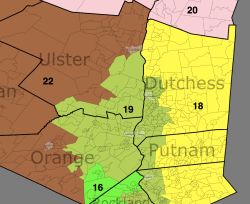
NY-17
Incumbent: Nita Lowey (D) lives in precinct Harrison 10 near Rye.
Population: 700372
| Wh | Bl | Hisp | Asn | Nat | Oth |
|---|---|---|---|---|---|
| 43 | 23 | 21 | 10 | 0 | 3 |
| New | Old 18 | |
|---|---|---|
| Obama % | 71.91 | 62 |
| McCain % | 27.53 | 38 |
Description: Within New York City, District 17 covers Whitestone in Queens and most of the eastern Bronx. It then continues along the shore (New Rochelle and Rye).
Nita Lowey used to represent parts of Bronx and Queens, and she can again. In compensation for taking away most of her current district’s population, I’ve given her a heavily Democratic district majority-minority district.



NY-18
Incumbent: John Hall (D) lives in precinct Dover 1 in Dover Plains.
Population:700344
| Wh | Bl | Hisp | Asn | Nat | Oth |
|---|---|---|---|---|---|
| 74 | 11 | 10 | 3 | 0 | 2 |
| New | Old 19 | |
|---|---|---|
| Obama % | 58.07 | 51 |
| McCain % | 41.05 | 48 |
Description: District 18 starts in Democratic Mt. Vernon next to the Bronx, and snakes its way up through Democratic White Plains to rural Putnam and Dutchess Counties.
This district is heavily Democratic, without cutting into the Hudson Valley precincts that I need for the new Democratic-leaning District 19.



NY-19
Incumbent: None.
Population: 700376
| Wh | Bl | Hisp | Asn | Nat | Oth |
|---|---|---|---|---|---|
| 71 | 11 | 12 | 3 | 0 | 3 |
| New | |
|---|---|
| Obama % | 58.20 |
| McCain % | 40.79 |
Description: District 19 lies in the Hudson Valley, including Poughkeepsie, Newburgh, Peekskill, and the Democratic portions of Rockland County. (See description of District 16 above.)
Although this district strongly favors Democrats at the federal level, there is no Democratic incumbent. Furthermore, the state legislators are all Republican, as are the mayors of Poughkeepsie and Newburgh. I believe that a Democratic non-politician along the lines of Hall, Murphy, or Owens would claim this seat. However, if the DCCC failed to recruit effectively, this district could fall to a local Republican.
Neither Sue Kelly (lost to Hall in 2006), John Sweeney (lost to Gillibrand in 2006), nor Jim Tedisco (lost to Murphy in 2009) lives in this district.



NY-20
Incumbent: Paul Tonko (D) lives in precinct Amsterdam city 1.
Population: 700342
| Wh | Bl | Hisp | Asn | Nat | Oth |
|---|---|---|---|---|---|
| 89 | 6 | 3 | 1 | 0 | 1 |
| New | Old 21 | |
|---|---|---|
| Obama % | 54.49 | 58 |
| McCain % | 43.68 | 40 |
Description: District 20 contains part of the Capital Region, including Albany.
This district is slightly less Democratic than its predecessor. Most notably, it gives up Democratic Schenectady and Troy in order to make the new District 21 safer.




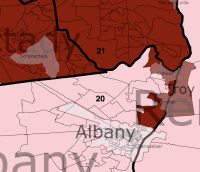
NY-21
Incumbent: Scott Murphy (D) lives in precinct Glens Falls 5; Bill Owens (D) lives in precinct Plattsburgh 3.
Population: 700425
| Wh | Bl | Hisp | Asn | Nat | Oth |
|---|---|---|---|---|---|
| 92 | 3 | 2 | 1 | 0 | 1 |
| New | Old 20 | Old 23 | |
|---|---|---|---|
| Obama % | 54.90 | 51 | 52 |
| McCain % | 43.41 | 48 | 47 |
Description: District 21 runs along the Vermont border, containing Schenectady, Troy, Saratoga Springs, and Plattsburgh.
The existing NY-20 and NY-23 were both created for Republican incumbents, and neither is particularly attractive to Democrats. Rather than contort district boundaries to preserve seats for both of these Blue Dogs, I prefer to carve up the moderate/Republican North Country to give safer seats to one of them and to Arcuri.
In a head-to-head primary, both candidates would have a reasonable chance of winning, since many of the Democratic votes would come from around Schenectady and Troy, which are presently in Tonko’s district.
Of course, there’s a real chance that one of these incumbents will lose in 2010. If that happens, then this district should favor the Democratic incumbent. Jim Tedisco (lost to Murphy) and Doug Hoffman (lost to Owens) both live in this district, but Dede Scozzafava (withdrew against Owens) does not.



NY-22
Incumbent: Maurice Hinchey (D) lives in precinct Hurley 3.
Population: 700380
| Wh | Bl | Hisp | Asn | Nat | Oth |
|---|---|---|---|---|---|
| 87 | 5 | 5 | 2 | 0 | 1 |
| New | Old | |
|---|---|---|
| Obama % | 53.24 | 59 |
| McCain % | 45.30 | 39 |
Description: District 22 contains Kingston, Middletown, Binghamton, and Elmira.
Giving Democratic Ithaca to Hinchey only makes sense if one is trying to pack Upstate Democratic votes in order to create Republican seats. This new district has enough Democrats from Binghamton and the Hudson Valley to be easily winnable.
Hinchey (born 1938) will probably retire during the next decade, and Republicans could make a play for this district in an open-seat election. However, the eastern part of the district is quickly becoming more Democratic (see Sue Kelly and John Sweeney), and I would expect Democrats to hold the seat.
Since the average district size increased by 4%, this new District 22 can span about the same amount of longitude without looking quite as goofy as the old NY-22.



NY-23
Incumbent: Michael Arcuri (D) lives in precinct Utica 4.
Population: 700382
| Wh | Bl | Hisp | Asn | Nat | Oth |
|---|---|---|---|---|---|
| 92 | 3 | 2 | 2 | 0 | 1 |
| New | Old 24 | |
|---|---|---|
| Obama % | 52.62 | 50 |
| McCain % | 45.66 | 48 |
Description: District 23 contains Potsdam, Utica, and Ithaca.
Arcuri looked surprisingly weak in the 2008 election. However, with the advantage of incumbency and a district that’s a few percent safer, he should be able to hold his seat. He is one of the few Democratic incumbents who may stay in Congress until 2030.


NY-24
Incumbent: Dan Maffei (D) lives in precinct DeWitt 3 near Syracuse.
Population: 700338
| Wh | Bl | Hisp | Asn | Nat | Oth |
|---|---|---|---|---|---|
| 87 | 7 | 2 | 2 | 1 | 2 |
| New | Old 25 | |
|---|---|---|
| Obama % | 55.45 | 56 |
| McCain % | 42.76 | 43 |
Description: District 24 contains Syracuse and Watertown.
This is the safest of the seats in the central part of the state. Its Democratic performance is similar to Maffei’s old district, but it crucially takes its non-Syracuse Democratic votes from the North rather than from the Rochester area. This allows the Rochester area to be split into Democratic-leaning districts.


NY-25
Incumbent: Eric Massa (D) lives in Corning city.
Population: 700395
| Wh | Bl | Hisp | Asn | Nat | Oth |
|---|---|---|---|---|---|
| 91 | 4 | 2 | 1 | 0 | 1 |
| New | Old 29 | |
|---|---|---|
| Obama % | 52.64 | 48 |
| McCain % | 45.92 | 50 |
Description: District 25 is based in the Rochester area, containing the eastern part of the city, and most of the northeastern suburbs. It goes along the Lake Ontario coast as far East as Oswego, and also extends to the Finger Lakes Region (Auburn, Geneva, Canandaigua) and down through rural areas to the Pennsylvania border.
This district is much safer for Massa than the old NY-29.


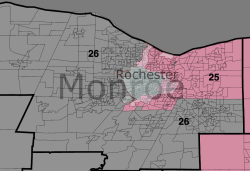
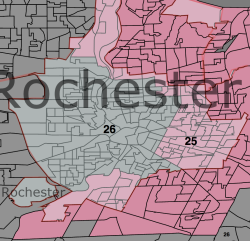
NY-26
Incumbent: Louise Slaughter (D) lives in precinct Perinton 14 in Fairport.
Population: 700170
| Wh | Bl | Hisp | Asn | Nat | Oth |
|---|---|---|---|---|---|
| 80 | 12 | 5 | 2 | 0 | 1 |
| New | Old 28 | |
|---|---|---|
| Obama % | 53.00 | 68 |
| McCain % | 45.73 | 30 |
Description: District 26 is also based in the Rochester area, containing the western part of the city and most of the suburbs. It contains rural areas (including Livingston and Allegany Counties) going South to the Pennsylvania border.
To create more safe Democratic seats in western New York, I give Slaughter’s Buffalo Democrats to the new NY-27 and give some of her Rochester Democrats to Massa in the new NY-25.



NY-27
Incumbent: None.
Population: 700157
| Wh | Bl | Hisp | Asn | Nat | Oth |
|---|---|---|---|---|---|
| 84 | 11 | 2 | 2 | 1 | 1 |
| New | Old 26 | |
|---|---|---|
| Obama % | 54.55 | 46 |
| McCain % | 43.90 | 52 |
Description: District 27 is based in the Buffalo area, containing the northern part of the city, Niagara Falls, and rural areas to the North and East.
On a map, it may appear as though this district should “belong” to Lee, if he decided to move into it. However, only about 300k of the residents are part of Lee’s current district. Nearly as many (270k) are part of Slaughter’s current district, and the remainder are largely Democrats from Higgins’s district.
Because there is no Democratic incumbent here, I’ve made it the safest Democratic seat of western New York. If Lee did decide to run here, he would face a very tough district full of Democrats who don’t know him. Furthermore, Lee is not a strong candidate. Despite a bitter three-way Democratic primary in 2008 that produced a weak candidate, Lee barely managed to outpoll McCain in his current district.
Byron Brown (mayor of Buffalo) and Alice Kryzan (lost to Lee in 2008) live in this district. Jon Powers (lost in the primary to Kryzan in 2008) and Tom Reynolds (retired in 2008) do not. I don’t know about Jack Davis (lost several times).

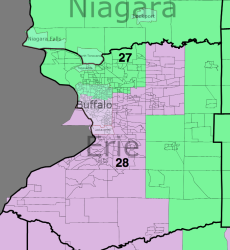
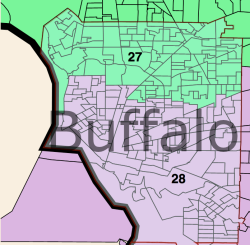
NY-28
Incumbents: Brian Higgins (D) lives in precinct South 19 in Buffalo; Chris Lee (R) lives in an unknown precinct in Clarence.
Population: 700176
| Wh | Bl | Hisp | Asn | Nat | Oth |
|---|---|---|---|---|---|
| 85 | 8 | 4 | 1 | 1 | 1 |
| New | Old 27 | |
|---|---|---|
| Obama % | 54.23 | 54 |
| McCain % | 44.11 | 44 |
Description: District 28 is based in the Buffalo area, containing the southern part of the city, the eastern and southern suburbs, and rural Chautauqua and Cattaraugus Counties.
Higgins would certainly beat Lee in an incumbent-incumbent matchup. A considerable majority of the population comes from Higgins’s old district, and the district leans safely to Democrats.



California Dreaming – 2010 House Races
With the midterms only 10 months away it is time now to cast our eyes over the biggest state in the country – California.
How will we fare in 2010?
Below the fold for all the details and hey go check out the 2010 Race Tracker Wiki over at Open Congress for all your House, Senate and Gubernatorial needs.
(Cross posted at Daily Kos, MyDD and Open Left)
All of the doom and gloom amongst naysayers about our chances in this years midterms simply does not tally when we drill down into race by race analysis in California.
For a start I think that all 34 Democratic incumbents are as safe as houses – yep including McNerney in the 11th and Sanchez in the 47th.
So what about all 19 Republican held districts?
Here we go:
CA-02 (Herger) – R+11,
Obama/McCain – 42.7/55
Kerry/Bush – 36.6/62
Voter Reg (D/R)- 10/2006 – 33.12/45.09
Voter Reg (D/R)- 10/2009 – 33.81/43.18
House result 2008 (D/R)- 42.1/57.9
Does anyone think we are going to win a R+11 district next year that we don’t already hold?
We don’t even have a candidate yet.
Enough said.
CA-03 (Lundgren) – R+6,
Obama/McCain – 49.2/48.7 (1592 Votes!)
Kerry/Bush – 40.8/58.2
Voter Reg (D/R)- 10/2006 – 36.14/42.70
Voter Reg (D/R)- 10/2009 – 37.73/39.58
House result 2008 (D/R)- 44/49.5
This one is definitely going to be competitive!
Bera led the COH race as at end of September 585K/446K – an impressive effort indeed. With all other Democratic candidates withdrawing and endorsing him and with a rapidly closing Voter reg gap this district will be the scene of a torrid race. Note also that Obama narrowly carried it.
CA-04 (McClintock) – R+10,
Obama/McCain – 43.9/54
Kerry/Bush – 37.4/61.3
Voter Reg (D/R)- 10/2006 – 30.28/47.86
Voter Reg (D/R)- 10/2009 – 31.14/45.83
House result 2008 (D/R)- 49.7/50.3
Does anyone think we are going to win a R+10 district next year that we don’t already hold? Especially as we don’t have a candidate yet and 2006/8 nominee Charlie Brown is definitely not running.
Enough said.
CA-19 (Radanovich OPEN) – R+9,
Obama/McCain – 46/52.1
Kerry/Bush – 37.9/61.1
Voter Reg (D/R)- 10/2006 – 36.09/46.73
Voter Reg (D/R)- 10/2009 – 37.19/43.62
House result 2008 (D/R)- Unopposed
Our candidates are seriously 2nd tier and need to step up massively if this is to be competitive. Do we have a State Rep who can run?
CA-21 (Nunes) – R+13,
Obama/McCain – 42.1/56.3
Kerry/Bush – 33.7/65.4
Voter Reg (D/R)- 10/2006 – 33.84/49.55
Voter Reg (D/R)- 10/2009 – 34.89/46.76
House result 2008 (D/R)- 31.6/68.4
Does anyone think we are going to win a R+13 district next year that we don’t already hold?
We don’t even have a candidate yet.
Enough said.
CA-22 (McCarthy) – R+16,
Obama/McCain – 38.3/59.7
Kerry/Bush – 31/67.9
Voter Reg (D/R)- 10/2006 – 30.06/51.21
Voter Reg (D/R)- 10/2009 – 31.29/48.31
House result 2008 (D/R)- Unopposed
Does anyone think we are going to win a R+16 district next year that we don’t already hold?
We don’t even have a candidate yet.
Enough said.
CA-24 (Gallegly) – R+4,
Obama/McCain – 50.5/47.7
Kerry/Bush – 43.1/55.7
Voter Reg (D/R)- 10/2006 – 34.15/44.12
Voter Reg (D/R)- 10/2009 – 35.83/41.82
House result 2008 (D/R)- 41.8/58.2
This one should be competitive but one of our candidates needs to put the foot down on the fundraising pedal. Is there a top tier candidate out there?
CA-25 (McKeon) – R+6,
Obama/McCain – 49.4/48.3
Kerry/Bush – 39.9/58.8
Voter Reg (D/R)- 10/2006 – 34.52/43.76
Voter Reg (D/R)- 10/2009 – 37.77/39.29
House result 2008 (D/R)- 42.2/57.8
This one too should be competitive but either Conaway fundraises like crazy or we get a better candidate.
CA-26 (Dreier) – R+3,
Obama/McCain – 51/47
Kerry/Bush – 43.7/55.1
Voter Reg (D/R)- 10/2006 – 33.54/44.42
Voter Reg (D/R)- 10/2009 – 35.67/40.50
House result 2008 (D/R)- 40.4/52.7
On paper this should be right up there but is Warner the guy to do it?
If so better start raising the dough.
CA-40 (Royce) – R+8,
Obama/McCain – 46.6/51.1
Kerry/Bush – 38.4/60.2
Voter Reg (D/R)- 10/2006 – 32.04/46.78
Voter Reg (D/R)- 10/2009 – 33.86/42.75
House result 2008 (D/R) – 37.4/62.6
No Candidate no chance. Simple really. Even with a good candidate it is a tough district.
CA-41 (Lewis) – R+10,
Obama/McCain – 43.7/54.2
Kerry/Bush – 36.9/61.8
Voter Reg (D/R)- 10/2006 – 32.18/47.80
Voter Reg (D/R)- 10/2009 – 34.12/44.20
House result 2008 (D/R)- 38.3/61.7
Does anyone think we are going to win a R+10 district next year that we don’t already hold? Only if Lewis bails out owing to ethical “issues”!
Enough said.
CA-42 (Miller) – R+10,
Obama/McCain – 44.9/53.2
Kerry/Bush – 36.9/62
Voter Reg (D/R)- 10/2006 – 28.88/49.79
Voter Reg (D/R)- 10/2009 – 30.56/46.16
House result 2008 (D/R)- 39.8/60.2
Does anyone think we are going to win a R+10 district next year that we don’t already hold?
Enough said.
CA-44 (Calvert) – R+6,
Obama/McCain – 49.5/48.6 (2532 Votes)
Kerry/Bush – 39.9/59
Voter Reg (D/R)- 10/2006 – 31.98/46.89
Voter Reg (D/R)- 10/2009 – 34.63/46.40
House result 2008 (D/R)- 48.8/51.2
Simple equation here. We have the candidate in Hedrick. If he can lift his fundraising game he may make a real of this. Remember he was the guy who delivered that 2008 result above.
CA-45 (Bono Mack) – R+3,
Obama/McCain – 51.5/46.9
Kerry/Bush – 43.1/56
Voter Reg (D/R)- 10/2006 – 35.85/45.53
Voter Reg (D/R)- 10/2009 – 37.81/42.08
House result 2008 (D/R)- 41.7/58.3
Pougnet is the mayor of Palm Springs and this will be a zinger IMHO. His fundraising is going well (347K COH as at end of September) and he obviously has a very high local profile.
CA-46 (Rohrabacher) – R+6,
Obama/McCain – 47.9/49.8
Kerry/Bush – 41.6/56.9
Voter Reg (D/R)- 10/2006 – 30.49/46.84
Voter Reg (D/R)- 10/2009 – 32.02/43.49
House result 2008 (D/R)- 43.1/52.6
No candidate presently this one is at best a long shot.
CA-48 (Campbell) – R+6,
Obama/McCain – 49.3/48.6 (2479 Votes)
Kerry/Bush – 40.4/58.3
Voter Reg (D/R)- 10/2006 – 27.13/49.32
Voter Reg (D/R)- 10/2009 – 29.40/44.77
House result 2008 (D/R)- 40.6/55.7
An intriguing district. Terribly low % of registered Dems and yet Obama won the district. Krom needs to put the foot down with her fundraising (126K COH as at end of September is not great) to make this an outside chance.
CA-49 (Issa) – R+10,
Obama/McCain – 45.1/53
Kerry/Bush – 36.5/62.5
Voter Reg (D/R)- 10/2006 – 28.50/47.96
Voter Reg (D/R)- 10/2009 – 30.94/43.86
House result 2008 (D/R)- 37.5/58.3
Does anyone think we are going to win a R+10 district next year that we don’t already hold?
Enough said.
CA-50 (Bilbray) – R+3,
Obama/McCain – 51.3/47.1
Kerry/Bush – 43.9/55.2
Voter Reg (D/R)- 10/2006 – 29.62/43.64
Voter Reg (D/R)- 10/2009 – 31.40/40.27
House result 2008 (D/R)- 45.2/50.3
We lost our best candidate here (Roberts), Busby is I think flawed and Emblem has yet to make a splash. And yet Obama won the district.
Either Emblem steps up her fundraising or we get a better candidate IMHO.
CA-52 (Hunter) – R+9,
Obama/McCain – 45/53.4
Kerry/Bush – 37.7/61.4
Voter Reg (D/R)- 10/2006 – 29.87/45.66
Voter Reg (D/R)- 10/2009 – 31.41/42.90
House result 2008 (D/R)- 39/56.4
Does anyone think we are going to win a R+9 district next year that we don’t already hold?
We don’t even have a candidate yet.
Enough said.
So in summary:
Competitive race:
CA-03, CA-45
Competitive if fundraising steps up:
CA-44, CA-48
A chance if the candidate steps up their fundraising or we find a more viable candidate:
CA-24, CA-25, CA-26, CA-50
Long shot:
CA-19, CA-40, CA-46
Forget it:
CA-02, CA-04, CA-21, CA-22, CA-41, CA-42, CA-49, CA-52.
Not bad 2 definitely competitive races and two more that could become so if our candidates step up the fundraising. Another 4 as well that could be competitive in the right circumstances. Not bad in an environment that is supposedly toxic for Democrats.
A last word also on the two supposedly vulnerable Democratic Districts:
CA-11 (McNerney) – R+1,
The GOP lost their best candidate when Del Arroz withdrew. If presumptive frontrunner Grape Grower Brad Goehring makes it out of the torrid Primary (7 candidates and counting) he will still remain a 2nd tier candidate, albeit one that can self fund. McNerney will be waiting with his 675K COH as at end of September. Following from an 11 point victory last year and near parity in voter reg (in 2006 there was a 5% GOP edge) McNerney will be just fine.
CA-47 (Sanchez) – D+4,
Does anybody really think that a D+4 District is going to flip in California next year? The Tran/Pham GOP Primary promises to be a zinger and the winner gets to take on an incumbent who got 69% of the vote last year and has 769K COH as at the end of September as well as a 12% party reg gap.
This one ain’t gonna flip.
What say you?
Scott Eliott’s first 2010 Election Projections
Scott Eliott (ElectionProjection.com) is up with his first nationwide ’10 projections, and it isn’t so bad.
Eliott is a wingnut – but he’s as objective as they come w/r/t election data. For example, he called every Senate race correctly in ’06 and just missed 1 in ’08.
His numbers after ’10:
Senate: 56-42-2 (D -2)
House: 249-186 (D -8)
I believe would be depicted as a huge D victory, a virtual endorsement of President Obama’s agenda by a majority of the country.
Scott Elliot has his views, which I disagree with strongly. But he runs a clean site, free of the virtol associated with the typical Wingnut blog (perhaps except for the banner ads).
His record is stellar – he was right on 48 of the 50 states in the ’04 election (he switched IA and WI). He called all six of our Senate gains in ’06, with obvious pain in his words.
Eight days before election day ’08, he said
Eight days from Election Day, here is this blogger’s conclusion: Barack Obama will win this election in a landslide. He will capture at least 350 electoral votes and win the popular vote by 7% or more.
2010 details – w/r/t the Senate, he currently sees
D losses in DE, CO, CT
D gain in OH
w/r/t the House, the current projection shows
R gains in
AL-02, FL-08, ID-01, KS-03, LA-03, MD-01, NM-02, OH-15, PA-07, TN-06, TN-08, and VA-05
While I disagree with him w/r/t FL-08, there will be a lot of wingnut money flowing to whomever opposes Grayson this year.
Eliott also projects D gains in
DE-AL, IL-10, LA-02, PA-06
His formulas are interesting as well. http://www.electionprojection…. –
a quantitative formula based on polls and pundits.
He even uses partisan polls – but includes a 3% correction factor.
The Northeast – Continuing the realignment in 2010?
That the Northeast has been trending blue in recent cycles is self evidently true. Will it continue in 2010?
Below the fold for all the details and hey go check out the 2010 Race Tracker Wiki over at Open Congress for all your House, Senate and Gubernatorial needs.
(Cross posted at Daily Kos, MyDD and Open Left)
Whilst current polls don’t look too good for incumbent Democrats across the Northeast I believe that we have hit the bottom. Now that Health Care reform is done I believe that the polls will rebound for Democrats, particularly in the Northeast.
Thus it is my contention that despite the current challenging environment the Northeast will continue its long term move towards the Democratic Party, despite a sure to be spiteful debate on cap and trade and despite an economic outlook that is improving in fits and starts.
The US Census defines the Northeast region as including 9 states as follows: Connecticut, Maine, Massachusetts, New Hampshire, New Jersey, New York, Pennsylvania, Rhode Island and Vermont. And aggregating across all 9 states the lay of the land looks like this:
States that voted for Obama: 9/9
Governors: 5/9
US Senators: 15/18 (Counting Sanders and Leiberman as Dems)
House Districts: 69/83
State Senates: 8/9
State Houses: 9/9
Where I think a race is a safe Democratic hold I won’t be saying anything about it.
Going state by state then:
Connecticut
Gubernatorial – With GOP Gov Jodi Rell not running again it is very likely to be a Dem pickup.
US Senate – Both Dems. If Dodd runs he may lose for any other Dem it is a safe hold.
US House – All Dem, all Safe (including Himes in the 4th.)
State Senate – 24D/12R – Safe
State House – 114D/37R – Safe
Maine
Gubernatorial – Whilst it seems that half of Maine is running for the open Gubernatorial mansion I believe that the Democratic nature of the state will lead to a Democratic retention.
US Senate – Both Repubs! Not on ballot in 2010
US House – All Dem, all Safe
State Senate – 20D/15R – Safe (Margin is growing).
State House – 95D/55R – Safe
Massachusetts –
Gubernatorial – Whilst Deval Patrick really hasn’t set the world on fire the 2nd tier nature of his potential opponents should see him safely re-elected.
US Senate – Both Dems (at least after the upcoming special election.)
US House – All Dem, all Safe
State Senate – 35D/5R – Safe
State House – 144D/16R – Safe
New Hampshire
Gubernatorial – Safe Dem
US Senate – definitely a race to watch. I will be stunned if Hodes loses here. Hodes has almost $1 million dollars COH and there is a divisive GOP primary in the offing also. New Hampshire, whilst less Blue than almost all of the other states in the North East, is not going to elect a Republican as US Senator in 2010.
US House –
NH-01 – There has been a lot of focus on both of the New Hampshire congressional races. I don’t get it to be honest – Shea Porter will win, not by much but she will win.
NH-02 – Again a lot of focus here including a lot of hand wringing about how vulnerable it is to switch. Not gonna happen folks. Gore, Kerry and Obama all won this district – Obama by 13 points – and we have a quality field of candidates running AND a divisive GOP Primary. Lead Dem Ann McLane Kuster has 250K COH as at the end of September.
State Senate – 14/10 – No change in 2008 really locks in our 2006 gains. If this one flips it will be a bad night for us.
State House – 223D/176R – Safe
New Jersey
Gubernatorial – Repub – Not on ballot in 2010
US Senate – Both Dems
US House –
NJ-02 – If State Senator Jeff Van Drew finally steps up and runs this race becomes very competitive. Hopefully he won’t wait until 2012. If State Sen Jim Whelan runs it could also get competitive in this district that Obama won 54/45 and that Bush won by less than 1% in 2004.
NJ-03 – Adler is safe.
NJ-04 – Gore carried this district and Obama lost 47/52 so a good candidate here is a must to get it on the radar instead of the second tier candidates we have run thus far.
NJ-05 – Unlikely to be on the radar in 2010.
NJ-07 – This district is winnable particularly with a freshman GOP incumbent. Obama carried it 51/48 also. Surprising then that there is no declared Dem candidate yet. Potentially a top tier race that will probably be a big miss for the DCCC.
NJ-11 – The safest GOP district in NJ and a rarity in the Northeast, (outside Pennsylvania,) a generically safe GOP district. Short of a fantastic candidate this one won’t be on the radar.
State Senate – Up in 2011
State House – Up in 2011
New York
Gubernatorial – Safe for Cuomo.
US Senate – Gillibrand will get over the line against 3rd tier opponents and Schumer is Safe too.
US House –
NY-03 – Unless Suozzi or another top tier candidate emerges then this will be a big miss for the DCCC.
NY-13 – McMahon is safe.
NY-20 – Murphy will prevail – bet on it. He had almost 1 Mill COH at the end of September!
NY-23 – One of two really competitive races in Dem held districts in NY. I think Owens will prevail, especially against Hoffman.
NY-24 – After a scare in 2008 Arcuri will be safe.
NY-25 – Maffei is safe.
NY-26 – Unless a good candidate pops up this will be a big miss for the DCCC.
NY-29 – Massa has his work cut out for him – that’s for sure. But for me Massa by a nose. Why? When was the last time the NY GOP won a District off us? Massa’s 500K COH as at end of September will help too.
State Senate – 32D/30R – A chamber to watch – big time. I expect us to hang onto or increase our majority.
State House – 109D/41R – Safe
Pennsylvania
Gubernatorial – A real worry this one could flip.
US Senate – 2 Dems – Whoever emerges from the Dem primary will beat Toomey. The good folk of Pennsylvania wouldn’t be crazy enough to sent Toomey to the US Senate would they?
US House –
PA-03 – Dahlkemper will have her work cut out to win this District that Obama JUST lost. Race to watch.
PA-04 – Altmire will be safe.
PA-05 – This central Pennsylvania district will not be on the radar unless we have an ultra conservative candidate. One of 4 super safe districts in the state for the Republicans.
PA-06 – Generic Dem beats generic Rep – Period. Doug Pike’s massive COH advantage (largely self funded) of 750K as at end of September should help him pull this one out.
PA-07 – Not quite sure why so many people are predicting this will flip. Top tier candidates for both parties makes for a tough race but this district was won by Gore, Kerry and Obama. Add in a competitive GOP Primary and it is Dem for me.
PA-09 – One of 4 super safe districts in the state for the Republicans. This central Pennsylvania district will not be on the radar unless we have an ultra conservative candidate. Yep just like PA-05.
PA-11 – Against Lou Barletta Kanjorski will be fine. Tough part of Pennsylvania for Democrats though.
PA-12 – Murtha is vulnerable but i expect him to survive (just).
PA-15 – Like PA-06 Obama carried every county in this one and yep it is also one of only 5 won by Kerry that is occupied by a GOP House Rep. Dem Callahan is a top tier challenger and is fundraising like one (325K COH as at end of Spetember).
PA-16 – Another super safe district for the GOP. Like the 5th and 9th unlikely to be a priority.
PA-18 – In theory could be vaguely competitive in 2010 (Bush only got 54% here in 2004) but unlikely given the low hanging fruit in the 6th and 15th.
PA-19 – Another super safe district for the GOP. Like the 5th, 6th and 16th unlikely to be a priority in 2010, unless Todd Platts lands the Government job he is chasing. Even then unlikely to be competitive.
State Senate – 20D/30R – Safe GOP
State House – 104D/99R – Definitely a chamber to watch.
Rhode Island
Gubernatorial – GOP Gov Don Carcieri is term limited so either a Dem or former Repub Sen now Indy Lincoln Chaffee will be elected. The GOP bench here is terrible.
US Senate – Both Dems
US House – All Dem, all Safe
State Senate – 35D/5R Safe
State House – 69D/6R Safe
Vermont
Gubernatorial – With GOP Gov Douglas not running the GOP have scored their best possible candidate in Lt Gov Brian Dubie; who will lose to a Dem (unless the Progressive Party act as a spoiler).
US Senate – Both Dems
US House – All Dem, all Safe
State Senate – 28D/7R Safe
State House – 95D/48R Safe
So with 10 months until election day it is off to the races!
What do you think?
Explaining the Swiss Minaret Vote
By: Inoljt, http://mypolitikal.com/
Switzerland’s landslide vote to ban Muslim minarets surprised many pundits and commentators, more familiar with the nation’s image as a bastion of tolerance and European enlightenment.
These results, in fact, are not so surprising. They derive from the peculiar structure of Swiss democracy, which effectively creates a voter base less diverse than the general public. These voters are generally predisposed to support such initiatives as the minaret vote.
I am specifically talking about Swiss citizenship. Becoming a Swiss citizen implies that one has become part of the Swiss people, and the Swiss have a very strict definitions of what this means. Since – of course – only citizens may vote, this strictness directly impacts the Swiss electorate.
While Switzerland may have an image as a tolerant place, its naturalization policy is one of the least tolerant in the Western world.
More below.
Achieving citizenship can be nearly impossible. Some communities routinely reject applicants connected in any manner to Africa or the Balkans, even if have they lived in Switzerland their whole lives. Many applicants must appear before a local citizenship committee, which asks deep-probing questions such as whether the applicant “can imagine marrying a Swiss boy,” or if said applicant likes Swiss music.
As a result, 21.9% of the Swiss population is foreign – one of the highest rates in the world. An aspiring immigrant may move to Switzerland, but neither he, nor his children, nor even his grandchildren will be guaranteed citizenship. Nearly 90% of Swiss Muslims face this situation, foreigners in a land some have lived their entire lives in.
Because Swiss immigrants are denied citizenship, they naturally cannot vote: only the Swiss people can. It is no wonder then, that Switzerland’s selectively chosen electorate regularly passes initiatives like the minaret law. Or that the anti-immigrant Swiss People’s Party won the most seats in the 2007 federal elections.
This is not to say that the Swiss people are particularly intolerant or bigoted. It is a naturally human tendency to be suspicious of outsiders. Nativist sentiments exist throughout the world, whether in English disdain for Eastern Europeans, Japanese dislike of white gaijins, Muslim discrimination against black Africans, or Russian pogroms against Jews.
The problem is that, by restricting citizenship (and therefore the ballot) to only certain groups, Switzerland’s peculiar system encourages this inherently human flaw. Switzerland is not the only country with xenophobic sentiment; many Americans, for example despise Spanish-speaking Latinos. But in the United States, these Latinos (or their children) can vote; in Switzerland 90% of Muslims can’t vote, because they are denied citizenship. That is why the Swiss People’s Party can run an ad like this:
The Swiss People’s Party won that referendum. Republicans, on the other hand, wish to appeal to the Latino electorate; very few would dare do such a thing.
If Switzerland is to prevent more minaret initiatives from passing, it should make naturalization easier – at the very least, for example, it could grant citizenship to third-generation citizens. In doing so, Switzerland can follow America’s lead, a country whose naturalization policy is among the most progressive in the world. America is also the world’s superpower. That is not a coincidence.
